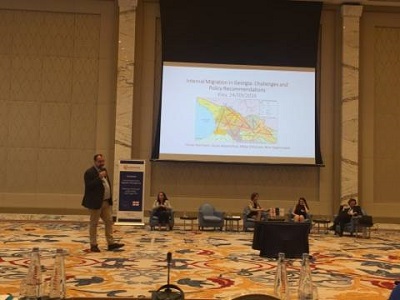ISET-PI’s Social Policy Research Center presented research results on internal migration in Georgia at an international conference “Recent Migratory Processes and Europe: Challenges and Opportunities” that took place on September 29-30th in the Tbilisi Biltmore Hotel. The presentation had already been given in the week before at a conference of the Stockholm Institute of Transition Economics in Kiev, Ukraine, and two weeks earlier at a workshop on regional economics held at the Ural Federal University in Ekaterinburg, Russia. The authors of the study are Florian Biermann, Zurab Abramishvili, Maka Chitanava, and Nino Doghonadze.
As Professor Biermann explained in his talks, internal migration in Georgia is a “sleeping giant”. Around 50% of the Georgian labor force are still employed in agriculture, compared to 1-3% in economically highly developed countries. Hence, as soon as agricultural productivity in Georgia picks up, a process that he thinks is overdue, rural-urban migration will receive additional impetus.
Politics may try to keep some control over this potentially explosive development, and the research of the SPRC may be instrumental to that end, as the SPRC team identified a couple of factors that influence the decision of people to migrate from one of Georgia’s region to another. Some of these factors seem to be specific to the Georgian context and cannot be found in other countries. For example, it turned out that the availability of jobs in manufacturing attracts migrants much more than jobs in the service sector. Georgia, which runs programs like “Produce in Georgia” that subsidize manufacturing firms, may thus use industrial policy as a means to reduce migration streams to Tbilisi by supporting the creation of manufacturing jobs outside the capital. Likewise, the SPRC found that internal migrants in Georgia are attracted by equality. Also this may be exploited by the government for steering migration streams, as inequality can be influenced, e.g., through social welfare measures. Members of minorities were found to be considerably less mobile than ethnic Georgians, which points at a potential goal conflict: while one wants to empower minority groups and integrate them better in the Georgian economy, this may lead to their increased migration to the cities, a process which bears economic and social risks.
As Professor Biermann pointed out, Georgia has to make a strategic decision whether it wants to curb internal migration or not. While there are chances in a quick urbanization process, he expressed the opinion that the risks outweigh the opportunities. In lack of industries that can absorb those who come to the cities, social hotspots, urban poverty, and a lack of acceptable housing space are very concrete scenarios. He argued that therefore it would be more prudent to slow down internal migration.











